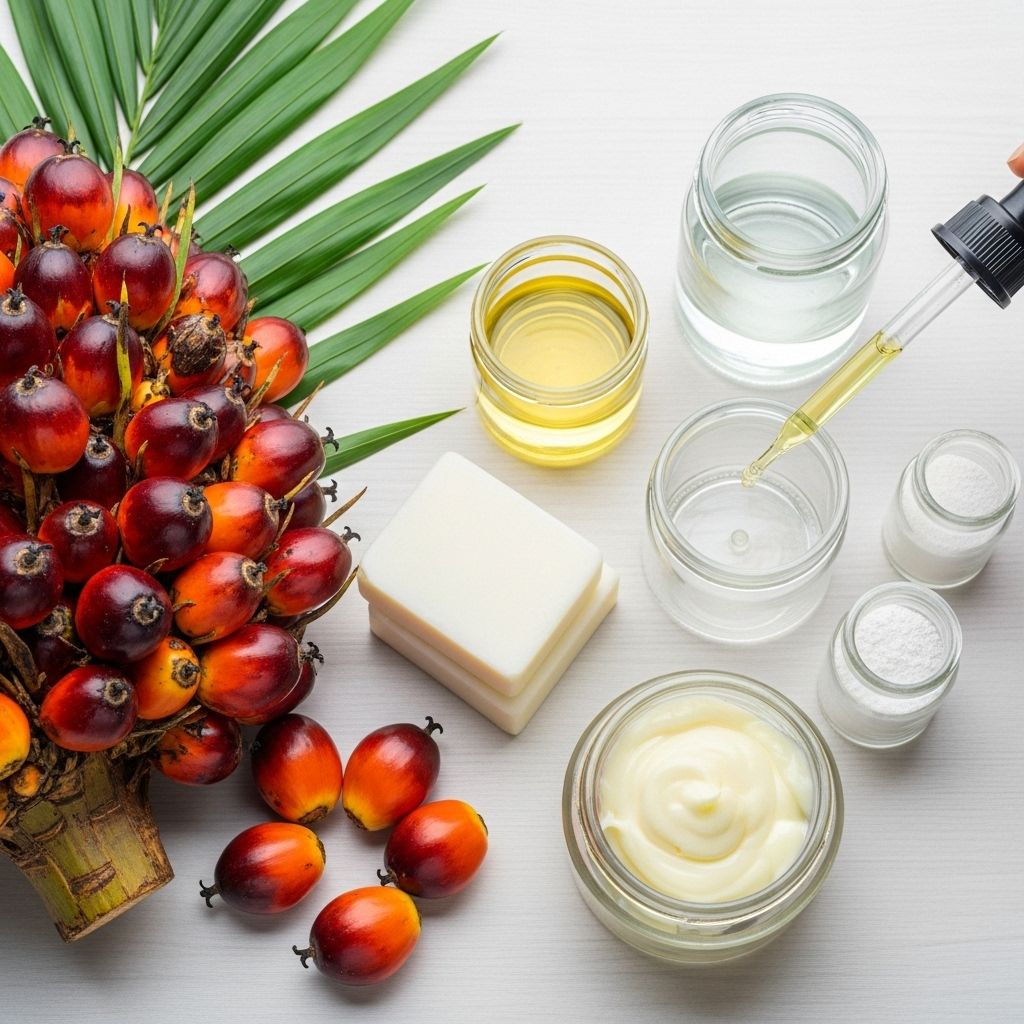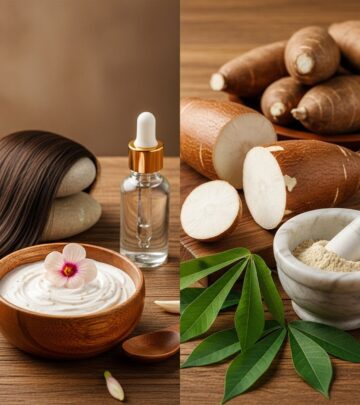Understanding Elaeis Guineensis (Palm) Derived Ingredients in Cosmetics
Explore the source, uses, benefits, safety, and sustainability of palm-derived ingredients in modern cosmetic and personal care products.

Elaeis Guineensis (Palm) Derived Ingredients: An In-Depth Guide
Elaeis Guineensis, commonly known as the African oil palm, is a tropical plant whose fruit and kernel yield a variety of oils widely utilized in cosmetics and personal care. The versatility and beneficial properties of palm-derived ingredients have positioned them as staples in skin creams, hair conditioners, and cleansing products. This article provides a comprehensive exploration into their origins, uses, safety profile, environmental impact, and emerging debates within the cosmetic industry.
What Are Elaeis Guineensis (Palm) Derived Ingredients?
Several ingredients are extracted from different parts of the palm tree (Elaeis guineensis):
- Palm Oil (Elaeis Guineensis oil): Extracted from the fruit pulp.
- Palm Kernel Oil (Elaeis Guineensis kernel oil): From the inner seed or kernel.
- Hydrogenated Palm Oil: Chemically altered to modify melting point and texture.
- Hydrogenated Palm Kernel Oil: Similar modification, starting from the kernel oil.
- Other Fatty Acid Oils: Such as palmitic, oleic, and linoleic acids.
These oils and their derivatives serve as foundational bases, emollients, occlusive agents, and texture enhancers in many formulations.
Chemical Properties and Physical Features
The main chemical constituents of Elaeis Guineensis oils include saturated and unsaturated fatty acids, notably:
- Palmitic Acid
- Oleic Acid
- Linoleic Acid
- Triglycerides
These compounds offer stability, consistency, and play crucial roles in skin conditioning and moisture retention.
| Ingredient | Source | Main Cosmetic Role |
|---|---|---|
| Palm Oil | Fruit pulp | Moisturizer, occlusive agent |
| Palm Kernel Oil | Seed/Kernel | Emollient, skin feel |
| Hydrogenated Palm Oil | Modified fruit pulp oil | Viscosity, stability, occlusivity |
| Hydrogenated Palm Kernel Oil | Modified seed/Kernel oil | Texture, stability |
Why Are Palm-Derived Ingredients Used in Cosmetics?
Oils derived from edible plants have been consumed and applied topically for thousands of years. In cosmetics, palm oil and its derivatives are widely valued for several reasons:
- Occlusive Properties: They act as skin conditioning agents, helping to seal moisture into the skin and prevent dehydration.
- Texture Enhancement: Hydrogenated forms are used for thickness and stability in creams and lotions.
- Versatility: Useful in both water-based and anhydrous (waterless) formulations due to compatibility and consistent performance.
- Long Shelf Life: Their fatty acid composition confers oxidative stability, reducing rancidity and extending product efficacy.
- Natural Origin: The renewable, plant-based source appeals to consumers seeking alternatives to petroleum-derived ingredients.
Core Functions in Personal Care Products
- Moisturizing and skin softening
- Protection from moisture loss
- Antioxidant support (e.g., vitamin E content)
- Improvement of skin and hair texture
- Healing and regenerative effects on minor skin irritations
Palm-derived oils are also compatible with essential oils and herbal extracts, making them valuable bases across diverse cosmetic products.
Benefits for Skin and Hair
Moisturization: Palm oil’s occlusive properties help lock in moisture, preventing dryness and leaving skin soft and supple.
Antioxidant Protection: Rich in vitamin E and other natural antioxidants, these ingredients can help neutralize free radicals that contribute to skin aging.
Texture Enhancement: Their chemical profile enables creams, lotions, and balms to achieve desired consistency without synthetic additives.
Skin Repair: Linoleic acid and other unsaturated fats support skin barrier integrity and facilitate recovery from minor wounds or irritations.
Hair Care: Palm kernel oil penetrates the hair shaft, nourishing it, reducing dryness, and promoting shine and strength.
Compatibility and Versatility
Palm-derived oils are suitable for all skin types, efficiently absorbed, and rarely leave a greasy residue. They help balance natural oil production, making them appropriate for both dry and oily skin, and are gentle enough for sensitive formulations.
Safety Profile of Palm-Derived Ingredients
Decades of use and scientific review demonstrate that Elaeis Guineensis oils are generally safe for topical use in cosmetics:
- Low risk of irritation for most users
- Non-comedogenic in formulated concentrations
- Suitable for vegan cosmetic products
However, some individuals may experience unique sensitivities; discontinuation is recommended if any reaction occurs.
Quality and Purity Controls
- Mechanical extraction and purification processes remove impurities and odors, ensuring high-quality oil for cosmetic use.
- Premium cosmetic brands source derivatives certified by the RSPO (Roundtable on Sustainable Palm Oil) or equivalent sustainability organizations to ensure safe, ethical, and environmentally responsible production.
Debate and Environmental Sustainability
Palm oil production, while highly efficient in oil yield per acre, has attracted scrutiny due to environmental concerns:
- Deforestation: Non-sustainable practices have led to the loss of tropical rainforests, endangering wildlife habitats and biodiversity.
- Social Responsibility: Economic and social impacts on local communities where palm oil is cultivated must be addressed.
- Sustainable Certifications: Organizations such as RSPO aim to promote ethical standards, preserving ecosystems and supporting fair labor practices.
Consumers increasingly seek products using sustainably sourced palm ingredients and transparent supply chains.
Comparison of Palm-Derived Ingredients vs. Alternatives
| Ingredient | Natural Source | Main Cosmetic Role | Texture | Sustainability Issues |
|---|---|---|---|---|
| Palm Oil | Palm fruit | Occlusive, moisturizer | Creamy, medium-thick | Deforestation, habitat loss |
| Coconut Oil | Coconut | Moisturizer, emollient | Rich, greasy | Variable sustainability |
| Mineral Oil | Petroleum | Occlusive | Heavy, slick | Non-renewable, fossil-based |
| Synthetic Silicones | Chemical | Emollient, texture enhancer | Slippery, lightweight | Non-biodegradable, fossil-based |
Common Cosmetic Products Utilizing Palm-Derived Ingredients
- Facial Moisturizers and Creams
- Body Oils and Lotions
- Hair Conditioners and Masks
- Soaps and Cleansers
- Makeup formulations (lipsticks, foundations)
- Natural deodorants and antiperspirants
These oils help achieve stability, desired skin feel, moisture, and overall product performance across a wide spectrum of personal care applications.
Safe Use and Recommendations
- Always check ingredient lists for palm oil derivatives if you have any known allergies.
- If irritation or discomfort arises, discontinue use and seek alternatives.
- Support brands that prioritize certified sustainable sourcing and transparency.
Frequently Asked Questions (FAQs)
Q: What is the difference between palm oil and palm kernel oil?
A: Palm oil is extracted from the flesh of the fruit, while palm kernel oil comes from the inner seed. Each offers distinct physical properties and roles in cosmetics; palm oil is softer and more occlusive, while palm kernel oil tends to be more stable and firm.
Q: Why is palm oil controversial?
A: Unsustainable palm oil farming has resulted in deforestation, habitat loss, and negative social impacts. However, certified sustainable palm oil production helps address these issues.
Q: Is palm-derived oil good for sensitive skin?
A: Generally, these oils are gentle, hypoallergenic, and suitable for most skin types, but sensitivity varies by individual; always patch test first.
Q: Are palm-derived ingredients vegan?
A: Yes, palm oil and its derivatives are plant-based and suitable for vegan cosmetic formulations.
Q: How do I know if my cosmetic products use sustainably sourced palm oil?
A: Look for brands disclosing RSPO certification or equivalent ethical sourcing on packaging or websites. Many credible companies now communicate their sustainability commitments transparently.
Conclusion: Role of Elaeis Guineensis in Modern Cosmetics
Palm-derived ingredients, when responsibly sourced, provide reliable performance, moisturization, and versatility for a wide array of cosmetic products. Industry standards continue to evolve toward greater transparency and environmental stewardship, giving consumers informed choices for ethical beauty without sacrificing efficacy or safety. Understanding the properties, benefits, and challenges associated with Elaeis Guineensis oils is key to navigating today’s personal care marketplace.
Read full bio of Sneha Tete











